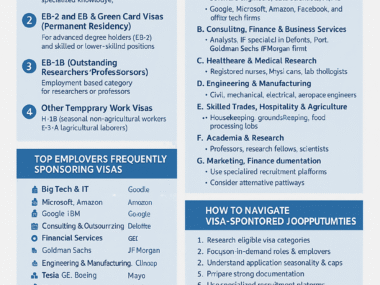Cheapest Countries to Study and Work for International Students: A Comprehensive Guide
Pursuing higher education abroad is a dream for millions of students worldwide. However, rising tuition costs, living expenses, and visa-related requirements often make it challenging for many to afford studying in popular destinations such as the United States, the United Kingdom, and Australia. Fortunately, numerous countries offer high-quality education at a fraction of the cost while also allowing international students to work part-time to support themselves.
This guide explores the cheapest countries to study and work for international students, focusing on factors such as tuition fees, living expenses, availability of part-time jobs, quality of education, and student visa policies. By the end, you’ll have a clearer picture of which countries combine affordability with opportunity—making your academic and career journey abroad both accessible and enriching.
Criteria for Selection
The following factors were considered when selecting the countries in this list:
- Affordable or free tuition fees
- Low cost of living
- Opportunities to work part-time
- Post-study work options
- Student-friendly visa policies
- Global recognition of degrees
1. Germany
Why It’s Cheap:
Germany is famous for its tuition-free education at public universities for both domestic and international students. Most universities only charge a small administrative fee ranging from €150 to €300 per semester.
Tuition Costs:
- Public universities: €0 – €500 per semester
- Private universities: €10,000+ per year (optional)
Cost of Living:
- Monthly expenses: €800 – €1,200
- Cities like Berlin and Leipzig are relatively cheaper
Work Opportunities:
- Students can work 120 full days or 240 half days per year
- Part-time jobs are available in cafes, research institutes, or as tutors
Post-Study Work:
- 18-month residence permit after graduation to seek employment
- Pathway to permanent residency
Pros:
- No tuition fees in public universities
- World-class education
- Strong economy and job market
Cons:
- Most undergraduate programs are in German
- High cost of rent in cities like Munich
2. Norway
Why It’s Cheap:
Public universities in Norway do not charge tuition fees for international students, regardless of nationality. However, the cost of living is relatively high.
Tuition Costs:
- Free in public institutions
Cost of Living:
- Monthly expenses: NOK 10,000 – NOK 12,000 (~USD $1,000 – $1,200)
- Accommodation and food are expensive
Work Opportunities:
- Students can work up to 20 hours per week
- Many part-time opportunities in hospitality and services
Post-Study Work:
- One-year job search visa after graduation
- Possibility of permanent residence
Pros:
- No tuition
- High standard of education
- Safe and scenic environment
Cons:
- High cost of living
- Limited English-taught bachelor’s programs
3. France
Why It’s Cheap:
France offers low tuition fees in public universities and allows international students to work up to 964 hours per year (~20 hours per week).
Tuition Costs:
- Public universities: €2,770/year (Bachelor), €3,770/year (Master)
- Grandes Écoles and private institutions are more expensive
Cost of Living:
- Monthly expenses: €700 – €1,200
- Paris is significantly more expensive
Work Opportunities:
- Up to 20 hours per week during term
- Internships and on-campus jobs available
Post-Study Work:
- Up to 2 years for graduates of master’s programs
- Pathway to permanent residency
Pros:
- Subsidized accommodation and healthcare
- Rich culture and language learning opportunity
- Strong emphasis on research and innovation
Cons:
- Bureaucracy can be complex
- High rent in large cities
4. Poland
Why It’s Cheap:
Poland offers low-cost education and living, with many courses taught in English. It is a rising destination for international students in Europe.
Tuition Costs:
- €2,000 – €4,000 per year for international students
Cost of Living:
- Monthly expenses: €400 – €800
- Cities like Warsaw and Krakow are affordable
Work Opportunities:
- Students can work part-time without a work permit
- Ample jobs in call centers, retail, and services
Post-Study Work:
- One-year stay back option to seek jobs
- Blue Card system for highly skilled workers
Pros:
- Low living and tuition costs
- High-quality education with international recognition
- English-taught programs widely available
Cons:
- Language barrier outside urban areas
- Limited post-study work opportunities compared to Western Europe
5. Malaysia
Why It’s Cheap:
Malaysia has emerged as an education hub in Southeast Asia, offering affordable tuition, low living costs, and British degree programs through partner campuses.
Tuition Costs:
- USD $3,000 – $6,000 per year
Cost of Living:
- USD $300 – $600/month
- Kuala Lumpur is more expensive
Work Opportunities:
- Students can work up to 20 hours per week in approved sectors
Post-Study Work:
- No formal post-study work visa
- Can transition to employment visa if hired
Pros:
- Affordable education and accommodation
- Culturally diverse and English widely spoken
- Tropical climate and friendly locals
Cons:
- Fewer top-ranked universities
- Limited work rights after graduation
6. India
Why It’s Cheap:
India offers some of the lowest education and living costs globally. Renowned institutions like IITs and IIMs offer programs at a fraction of the cost.
Tuition Costs:
- USD $500 – $2,000 per year at public universities
Cost of Living:
- USD $150 – $400/month
Work Opportunities:
- Limited on-campus work allowed
- Not a traditional work-study destination
Post-Study Work:
- No structured post-study work visa
- Can stay if employed under proper visa
Pros:
- Extremely low costs
- Rich culture and growing tech industry
- Expanding private education sector
Cons:
- Overcrowding and pollution in urban areas
- Complex visa and work rules
7. Mexico
Why It’s Cheap:
Mexico has low tuition and affordable living. Several universities offer programs in English, particularly in business and engineering.
Tuition Costs:
- USD $1,000 – $5,000 per year
Cost of Living:
- USD $300 – $600/month
Work Opportunities:
- Students may work part-time with employer sponsorship
Post-Study Work:
- No formal graduate work visa
- Must switch to employer-sponsored work visa
Pros:
- Warm climate, vibrant culture
- Spanish-language learning opportunities
- Growing private university sector
Cons:
- Limited English-taught programs
- Safety concerns in some regions
8. Argentina
Why It’s Cheap:
Argentina offers free or low-cost education at public universities and a relatively low cost of living. Buenos Aires is a popular student city.
Tuition Costs:
- Free at public universities
- USD $2,000 – $5,000/year at private universities
Cost of Living:
- USD $300 – $500/month
Work Opportunities:
- Students can work up to 20 hours/week
Post-Study Work:
- Must convert visa if transitioning to employment
Pros:
- Free public education
- High literacy and education standards
- Culturally rich and vibrant lifestyle
Cons:
- Political and economic instability
- Spanish is necessary for communication
9. Czech Republic
Why It’s Cheap:
Tuition is free for programs taught in Czech. English-taught programs are inexpensive, and the cost of living is lower than Western Europe.
Tuition Costs:
- Free (in Czech)
- English programs: €2,000 – €5,000/year
Cost of Living:
- €350 – €700/month
Work Opportunities:
- EU citizens can work without restrictions
- Non-EU students can work part-time (20 hrs/week)
Post-Study Work:
- Extendable student visa for job search
- Pathway to residence and work permit
Pros:
- Beautiful cities and history
- Affordable education and living
- Safe and centrally located in Europe
Cons:
- Czech language barrier for some programs
- Limited scholarships for non-EU students
10. Taiwan
Why It’s Cheap:
Taiwan offers quality education with low tuition and a growing number of programs taught in English. It’s a rising destination in Asia.
Tuition Costs:
- USD $1,600 – $3,000 per year
Cost of Living:
- USD $300 – $600/month
Work Opportunities:
- Up to 20 hours per week during semester
Post-Study Work:
- May stay if offered employment
- Must apply for work permit after graduation
Pros:
- Technologically advanced
- Friendly environment and safety
- Scholarships available for international students
Cons:
- Language barrier outside universities
- Limited global recognition of some institutions
Summary Comparison Table
| Country | Tuition (Year) | Living Cost (Month) | Part-Time Work | Post-Study Work |
|---|---|---|---|---|
| Germany | Free – €500 | €800 – €1,200 | Yes (120 days) | Yes (18 months) |
| Norway | Free | $1,000 – $1,200 | Yes (20 hrs) | Yes |
| France | €2,770 – €3,770 | €700 – €1,200 | Yes (20 hrs) | Yes |
| Poland | €2,000 – €4,000 | €400 – €800 | Yes | Yes |
| Malaysia | $3,000 – $6,000 | $300 – $600 | Yes (20 hrs) | Limited |
| India | $500 – $2,000 | $150 – $400 | Limited | Limited |
| Mexico | $1,000 – $5,000 | $300 – $600 | Limited | Limited |
| Argentina | Free – $5,000 | $300 – $500 | Yes | Limited |
| Czech Republic | €0 – €5,000 | €350 – €700 | Yes (20 hrs) | Yes |
| Taiwan | $1,600 – $3,000 | $300 – $600 | Yes (20 hrs) | Yes |
Final Thoughts
Choosing a country to study abroad involves balancing tuition fees, living expenses, part-time work opportunities, and long-term prospects. Countries like Germany, France, Poland, and the Czech Republic offer excellent value for money with high educational standards and favorable student policies. Meanwhile, Malaysia, India, and Mexico offer a unique cultural experience at a low cost, ideal for budget-conscious students.
Before applying, students should:
- Research visa and work permit policies
- Understand the language requirements
- Look into scholarships or tuition waivers
- Evaluate long-term goals (e.g., stay back, work, or return home)
By carefully selecting the right destination, international students can achieve academic excellence without incurring crippling debt.
![]()




